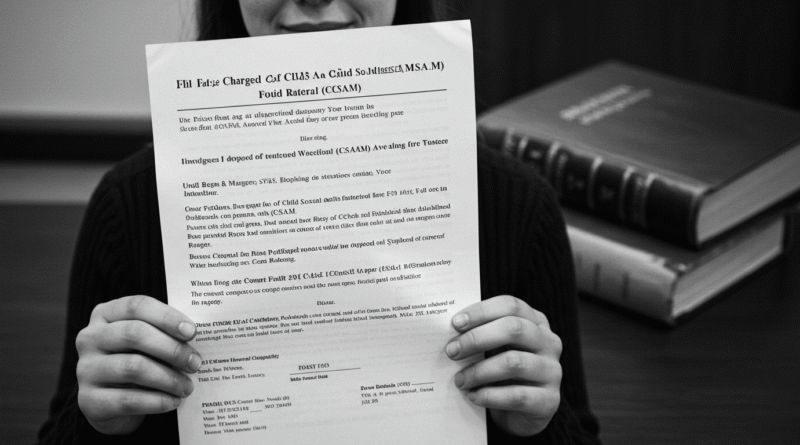When Justice Gets It Wrong: False Charges of CSAM Dropped
Imagine waking up one morning, and your entire world has flipped upside down — your name’s in the headlines, your reputation’s in tatters, and the charge? Possession or distribution of CSAM (Child Sexual Abuse Material). It’s one of the most serious accusations out there. But what if it wasn’t true?
That’s where the real nightmare begins.
False allegations are rare — but they do happen. And when they do, they ruin lives. In this article, we’ll take a deep dive into the complex and emotionally charged subject of false charges of CSAM dropped, what leads to them, how the justice system responds, and what comes next.
What Does It Mean When False Charges of CSAM Are Dropped?
So, let’s break it down.
When someone is falsely accused of possessing or distributing CSAM and the charges are later dropped, it means the prosecution has found insufficient evidence, mistaken identity, or even malicious intent behind the accusation. In simple terms: the accused didn’t do it — and the legal system eventually caught up.
But here’s the kicker — the damage often lingers long after the charges vanish.
People may lose their jobs, face isolation from family and friends, or be targeted online — all from something they didn’t do. Even with charges dropped, public opinion doesn’t always update itself with the same enthusiasm as it did when the accusation first spread.
Common Reasons Why False CSAM Charges Are Filed
Not every accusation is rooted in truth. Sometimes, things go horribly wrong due to tech glitches, human error, or worse — a setup. Let’s explore some real-world reasons:
| Cause of False Accusation | Explanation |
|---|---|
| Hacked Devices | Malware can plant illicit files on devices without the owner’s knowledge. |
| Shared Networks | Public Wi-Fi or family-shared networks can create misattributions. |
| Malicious Intent | Angry partners, ex-friends, or even co-workers may falsely report someone. |
| Mistaken Identity | Someone else’s data or activity gets tied to the wrong person. |
| Faulty AI/Scanners | Over-aggressive AI filters flag innocent files like medical images or art. |
In some cases, entire investigations are launched on weak digital breadcrumbs — things that only look incriminating but lack context.
Legal Path: From Accusation to Dropped Charges
Here’s what the usual legal process looks like when someone is falsely accused and eventually cleared:
| Stage | Details |
|---|---|
| Investigation Begins | Law enforcement receives a tip, complaint, or auto-flagged content. |
| Search/Seizure | Devices are confiscated and digital forensics begins. |
| Preliminary Charges | Based on initial findings, charges may be filed. |
| Legal Representation | The accused hires (or is assigned) a defense attorney. |
| Further Review | Evidence is reviewed, and counter-evidence is introduced. |
| Charges Dropped | If no credible evidence exists, the case is dismissed or withdrawn. |
This process can stretch for months or even years, and during this time, the accused might live under a cloud of suspicion and fear. Even when the truth comes out, the emotional and social toll is often irreversible.
Life After the Charges Are Dropped
When the words false charges of CSAM dropped finally appear in your case file, you’d expect life to go back to normal, right? Well… not exactly.
Here’s what many falsely accused people deal with post-dismissal:
- Stigma and Public Shaming: Even after being cleared, rumors and news stories stick.
- Employment Issues: Explaining a background check flag — even if resolved — is tough.
- Mental Health Struggles: Anxiety, PTSD, and depression are common.
- Online Harassment: Accusations don’t disappear from the internet just because they weren’t true.
Support groups, legal action for defamation, and mental health counseling become essential tools in the journey back to normalcy.
FAQs About False Charges of CSAM Dropped
1. How common are false charges of CSAM?
They’re relatively rare, but they do happen — and when they do, they have devastating effects. Most false charges stem from digital misunderstandings or malicious reporting.
2. What should someone do if falsely accused?
Get legal help immediately. Do not try to explain yourself to investigators without an attorney. Preserve all communications and device records.
3. How long does it take for charges to be dropped?
It varies. Some cases are resolved in weeks, others drag on for years. It depends on evidence, legal counsel, and investigative efficiency.
4. Can someone sue for being falsely accused of CSAM?
Yes, if there’s proof of malicious intent or negligence. Many falsely accused individuals pursue defamation or malicious prosecution claims.
5. Will dropped charges show up on background checks?
In some regions, yes. Even dropped charges may appear unless expunged or sealed. Always request expungement after a case is dismissed.
Conclusion: Justice Isn’t Always Swift — But It Can Be Served
False accusations — especially involving CSAM — are no joke. They crush reputations, destroy relationships, and cast long shadows over innocent people. But when the truth comes out and false charges of CSAM are dropped, it’s a small but powerful step toward reclaiming a life once derailed.
If you or someone you know is in this situation, know this: there is hope. And while the road is hard, the destination — justice, freedom, and peace of mind — is worth fighting for.
Custom Message:
Thanks for reading this important guide on false charges of CSAM dropped. Awareness and understanding are the first steps in preventing miscarriages of justice and supporting those who’ve been wrongly accused.



